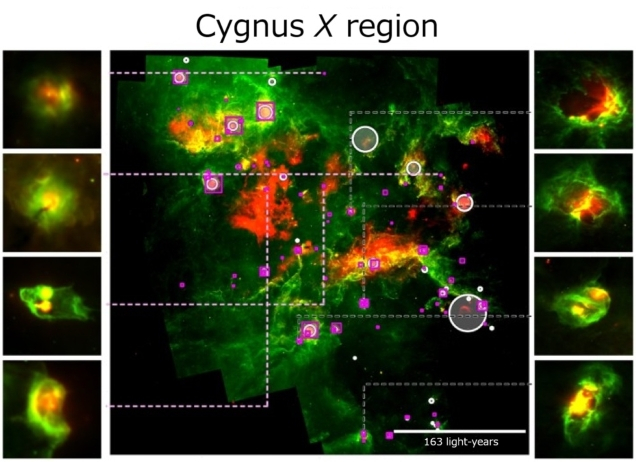Research News
Mar 21, 2025
- Science
Deep dive into space turns up new Spitzer bubbles
Using AI image recognition, deep learning model efficiently and accurately finds structures related to star formation
Composite image of bubble-like structures detected using infrared observation data of the Milky Way obtained by the Spitzer Space Telescope
The images on the left show newly detected bubble-like structures, while the images on the right show the bubble-like structure detected in this study and previous studies. By using wavelengths of 8 μm (green) and 24 μm (red), it is possible to detect the bubble structures created by the formation of high-mass stars.
Credit: Osaka Metropolitan University

To learn more about the deepest reaches of our own galaxy and the mysteries of star formation, Japanese researchers have created a deep learning model. The Osaka Metropolitan University-led team used artificial intelligence to pore through the vast amounts of data being acquired from space telescopes, finding bubble-like structures that had not been included in existing astronomical databases.
The Milky Way galaxy we live in, like other galaxies in the universe, has bubble-like structures formed mainly during the birth and activity of high-mass stars. These so-called Spitzer bubbles hold important clues to understanding the process of star formation and galaxy evolution.
Graduate School of Science student Shimpei Nishimoto and Professor Toshikazu Onishi collaborated with scientists from across Japan to develop the deep learning model. Using data from the Spitzer Space Telescope and James Webb Space Telescope, the model employs AI image recognition to efficiently and accurately detect Spitzer bubbles. They also detected shell-like structures that are thought to have been formed by supernova explosions.
“Our results show it is possible to conduct detailed investigations not only of star formation, but also of the effects of explosive events within galaxies,” stated graduate student Nishimoto.
Professor Onishi added, “In the future, we hope that advancements in AI technology will accelerate the elucidation of the mechanisms of galaxy evolution and star formation.”
Funding
This work was supported by the ‘Young interdisciplinary collaboration project’ in the National Institutes of Natural Sciences (NINS) and JSPS KAKENHI Grant Numbers JP23H00129, JP18H05440. This work was also supported by JST SPRING, Grant Number JPMJSP2139.
Paper information
Journal: Publications of the Astronomical Society of Japan
Title: Infrared Bubble Recognition in the Milky Way and Beyond Using Deep Learning
DOI: 10.1093/pasj/psaf008
Authors: Shimpei Nishimoto, Toshikazu Onishi, Atsushi Nishimura, Shinji Fujita, Yasutomo Kawanishi, Shuyo Nakatani, Kazuki Tokuda, Yoshito Shimajiri, Hiroyuki Kaneko, Yusuke Miyamoto, Tsuyoshi Inoue, and Atsushi M. Ito
Published: 18 March 2025
URL: https://doi.org/10.1093/pasj/psaf008
Contact
Toshikazu Onishi
Graduate School of Science
Email: tonishi[at]omu.ac.jp
*Please change [at] to @.
SDGs

